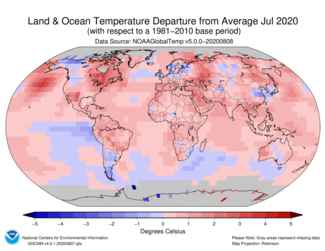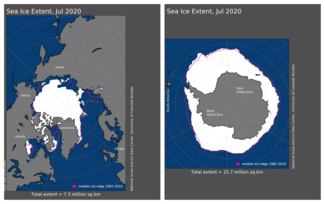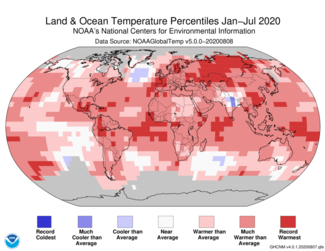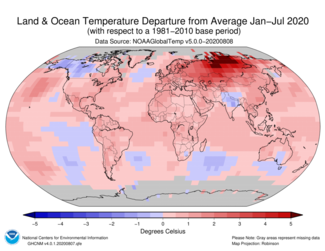Globally, July 2020 tied as second-warmest July on record; record low July Arctic sea ice extent

The July 2020 globally averaged land and ocean surface temperature departure from average tied with 2016 as the second highest for the month in the 141-year NOAA global temperature dataset record, which dates back to 1880.
This monthly summary, developed by scientists at NOAA National Centers for Environmental Information, is part of the suite of climate services NOAA provides to government, business, academia and the public to support informed decision-making.
July 2020 Temperature
The July 2020 global land and ocean surface temperature was 1.66°F (0.92°C) above the 20th-century average of 60.4°F (15.8°C), tying with 2016 as the second-highest July temperature in the 141-year record. The July 2020 global land and ocean surface temperature was only 0.02°F (0.01°C) shy of tying the record warm July of 2019
- July 2020 marked the 44th consecutive July and the 427th consecutive month with temperatures, at least nominally, above the 20th-century average.
- Nine of the 10 warmest Julys have occurred since 2010; the six warmest Julys have occurred in the last six years (2015-2020).
- The most notable warm temperature departures of at least +3.6°F (+2.0°C) were present across the North Pacific Ocean, the southwestern and northeastern contiguous U.S., eastern Canada and across parts of western Asia and eastern Antarctica. Record warm July temperatures were widespread across the North Indian Ocean, southeastern Asia, and the western Pacific Ocean. Other areas with record warm July temperatures were present across parts of the Caribbean Sea, northern South America, North America and the North Pacific Ocean. Cooler-than-average July temperatures were limited to small portions of northern North America, northern Atlantic Ocean, Scandinavia, eastern China, southern South America and the eastern tropical Pacific Ocean. However, no land or ocean area had a record cold July temperature.
- The Caribbean region had its warmest July on record, while North America had its second warmest July on record. Africa and South America had a July temperature departure from average that ranked among the nine highest on record.
- The Northern Hemisphere land and ocean surface temperature was the highest for July on record at 2.12°F (1.18°C) above average.
Sea Ice
Arctic sea ice extent for July 2020 was the smallest-July extent in the 42-year record at 846,000 square miles (23.1%) below the 1981–2010 average, according to analysis by the National Snow and Ice Data Center (NSIDC) using data from NOAA and NASA. The July 2020 Arctic sea ice extent was smaller than the previous record set in 2019 by 120,000 square miles, which is equivalent to the size of Vietnam. The 10 smallest July Arctic sea ice extents have occurred since 2007.
Antarctic sea ice extent during July 2020 was 120,000 square miles, or 1.9%, below the 1981-2010 average and the ninth-smallest July extent on record. July 2020 marked the fourth consecutive July with Antarctic sea ice extent below average.
January-July 2020
The year-to-date global land and ocean surface temperature was the second highest in the 141-year record at 1.89°F (1.05°C) above the 20th-century average of 56.9°F (13.8°C). This value is only 0.07°F (0.04°C) less than the record set in 2016.
- The January-July global land and ocean surface temperature was warmer-than-average across much of the globe. The most notable warm January-July temperature departures were observed across much of northern Asia, where temperatures were 3.6°F (2.0°C) above average or higher. Meanwhile, the most notable cool temperature departures of −1.8°F (−1.0°C) or cooler occurred across Alaska, parts of western Canada and northern India.
- Record warm January-July temperatures were present across a large portion of northern Asia, as well as parts of Europe, China, Mexico, northern South America and the Atlantic, northern Indian and Pacific oceans. No land or ocean areas had record cold January-July temperatures.
- Europe, Asia, the Gulf of Mexico, and the Caribbean region had their warmest January-July temperature departure on record, while South America and Africa had a January-July temperature that ranked among the four warmest such period on record.
- According to a statistical analysis done by NCEI scientists, the year 2020 is very likely to rank among the five warmest years on record.
For a more complete summary of climate conditions and events, see our July 2020 Global Climate Report.









